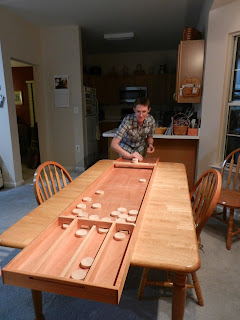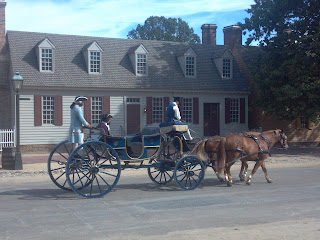Well, ask and ye shall receive. I wanted a little more
adventure for the summer; my friend Jennifer needed to use some vacation time; put
those together and viola! One more week of fun before the school year starts.
The best parts of the week – laughing, talking, laying aside
the stress of normal life – can’t be easily documented. But, at the risk of
sounding like a travelogue, here are some of the highlights of our weeklong
venture:
 |
| The Governor's Palace |
We spent a very hot
day at Colonial Williamsburg. While checking the weather on my phone, I
inadvertently stumbled across a good illustration of the difference between the
Virginia climate and the Utah climate. As displayed on my weather widget:
Temperature in Salt Lake City = 86,
feels like 84.
Temperature in Williamsburg = 96; feels
like 105.
And that’s why I don’t plan on living any farther south than
I already do.
 |
The newest building in Williamsburg:
the Market House. |
 |
Printing the Declaration of Independence
at the colonial printshop. |
Happily, it wasn’t too hot to keep us from enjoying the day.
We went to the military encampment and were immediately taken up as new
recruits, whereupon we were drilled in the proper methods of lining up,
marching, and firing rifles. (For future reference, rifles go “BOOM!” They do
not go “bang” or “pow.” And they never go “pew! pew! pew!”) We were also shown how
to fire a cannon and instructed on how to tighten the snares on a drum. Afterward,
our commanding officer told us to report at 7 am the next morning for further
training. We were told we wouldn’t get breakfast until our training improved,
so we blatantly disobeyed that order and went AWOL.
 |
This cannon goes off periodically throughout
the day as a demonstration for new recruits. |
 |
Jennifer putting her new military
skills to use in the guardhouse. |
We also went to the cabinet-making shop, where you can find
everything from a cradle to a coffin, but mostly chairs and desks and cabinets.
The best item is, perhaps, a handmade harpsichord, which you can play if you ask
nicely (we did).
 |
Jennifer's harpsichord playing earned
a round of applause. |
Another highlight of that day was the brick yard. The
colonists dig up the clay and mix in water by stomping through it over and over
again. After getting the rocks out, they move it to a second pit and let the visitors
join in. Result: many muddy feet and a lot of happy children. (They let adults
in too. I was tempted, but I was wearing white pants and thought getting in a
pit of clay might not end well. Hopefully I’ll get back there another time when
I’m more appropriately attired.)
 |
The professionals are very kind to find
all the rocks before they put the
tourists to work stomping in the
clay pits. |
Following the stomping, the bricks are formed in wooden
molds, left to dry, and fired (which is done by building a kiln over the stacks
of bricks, then burning fires between them for about a week). The fire changes the bricks’ colors. They start
out a light tan. They end up anywhere from a pale red (if they’re far from the
heat) to a deep red (the best variety, not too close to the heat, but not too
far away) to black (if they’re right by the flames).
 |
The bricks have to dry out for several weeks
before they can be fired. There are thousands
waiting for the fiery furnace. |
 |
| This is a dry, but as yet unfired brick. |
The brickmakers gave us another good east coast climate
explanation. We were told that out west, bricks can just be left to dry, then
go straight into a building. But here in the humidity, they’ll crumble if they
aren’t fired to get all the moisture out. The Williamsburg brick yard is the
only fully operating fired brickmaker (if I remember correctly), so they get
large orders for their wares from many places.
 |
The magazine houses a very big gun
(over 5 feet long, I think) . . . |
 |
| . . . and a very small cannon. |
After a few more stops and traversing DOG Street several
times, we ended the day with some cinder toffee, which is fabulous not only because
it’s tasty, but also because it looks wacky.
 |
And this is cinder toffee.
Yes, that is only one piece. |
 |
She's smiling a little too much
considering she's in the gaol. |
 |
| And this is me cheerfully trying to escape. |
 |
The fife and drum corps is more colorful
in the summer than in the winter when
they wear their red coats. |
 |
General Washington giving the
locals an encouraging speech. |
 |
| The Colonial Capitol. |
Our next adventure was at Mt. Vernon, the erstwhile home of George Washington. The plantation is pleasant, the garden is beautiful, the house is interesting, and the museum is excellent. It is well worth a trip to the northern confines of Virginia.
 |
Mt. Vernon (and scaffolding because they were re-shingling
the roof). The building looks like it's covered in stone, but
it's really wood with a paint and sand covering deliberately
trying to look like stone. |
 |
| One of the stained glass windows in the museum. |
 |
| Out in Washington's garden . . . |
 |
. . . where there are some
very tall plants. |
 |
| Washington's innovative 16-sided treading barn. |
 |
| Doing a little work on the plantation. |
 |
| Washington's pier out on the Potomac. |
After our day at Mt. Vernon, we spent the night with my aunt
and uncle, who kindly loaned us some beds to save us some driving time. Even
better, my aunt gave us a dulcimer lesson, we had a few rousing games of
Sjoelbak (Dutch shuffleboard), and we were fed a delicious Dutch breakfast of
“mousies” (or “vruchten hagel”)the next morning. The half of me that is Dutch
was in heaven. And the other half of me
was heartily enjoying it.
(I’m happy to brag that my first shot of Sjoelbak went
straight in the four-point slot, no doubt thanks to many hours playing in
Grandma and Grandpa’s basement.)
 |
| Dulcimer lesson. |
 |
| This is Sjoelbak. |
 |
| And this is my game face. |
After our delicious Dutch breakfast, we headed to Shenandoah
National Park, where we spent a good portion of the day in fog. It was
beautiful fog, of course. The sun eventually came out and we were able to see
the rolling green mountains. The Blue Ridge Mountains aren’t rocky and stark or
red and sculpted like mountains in the west; they’re softened lumps tamed by endless
trees. But still worth a visit.
 |
| Did I mention it was foggy? |
Shenandoah also has black bears; and we saw several (one
meandering across the way and a few cubs up in a tree – way up; they were high
enough to bend the branches they were sitting on). The bears became, in fact,
the main attraction for the hikers we passed along the Dark Hollow Falls trail.
(I’m sure the hikers appreciated the waterfalls as well.)
 |
There are bears in this picture.
I promise. |
 |
| The first part of Dark Hollow Falls. |
 |
| Tree roots made some nice steps along the trail. |
 |
| Everything is bigger out west . . . except the bugs. |
 |
| I love rocks. |
 |
| Dark Hollow Falls |
Feeling our Shenandoah hiking was insufficient, we opted to
spend another day on some local trails near the shore. We first went to see the
Yorktown Monument (which Jennifer had only seen at dusk before; it’s a little
easier to appreciate in the daylight). Then we spent a few hours wandering York
River State Park and the trails around Taskinas Creek. We ended our shoreline
day with a tasty fish dinner at the Bone Fish Grill.
 |
There is a random stand of bamboo
close to the Yorktown Monument.
It makes me happy. |
 |
| Taskenas Creek, in York River State Park. |
 |
We had to hike down to all the "overlooks" on the trail.
It is a weird concept for my brain. |
 |
Fossil beach.
(I don't know if there are any fossils,
but there are lots of broken shells,
sticks to throw in the water, and
tree trunks to climb on.) |
 |
The donuts from this place
are scrumptious. |
Our Sunday was spent at church, riding the ferry from Jamestown
to Scotland (no, not that Scotland),
and feeding turtles. We intended to feed some birds, but we didn’t think to
pull out my stale Honey-Nut Cheerios for the seabirds that were following the
ferry; then when we stopped at the lake, the ducks and the geese were no-shows.
So the turtles got all the treats instead.
 |
The little bit of Old Jamestown that is
visible from the ferry. |
 |
| Mine? |
Our last big adventure was Appomattox Court House. It was a
good time to visit, as they have some special items on display due to the Civil
War sesquicentennial. My impression coming out of Appomattox is that it is a
miracle the nation survived; and the Lord put specific leaders in place so it
would. What a forgiving, humble, generous, unconventional way for a civil war
to end.
 |
| Robert E. Lee's copy of the Surrender Terms. |
 |
Jennifer on the back deck
of the courthouse. |
 |
Parole passes were printed here for all of
Lee's soldiers so they could go straight home. |
 |
A little bit of fall sneaking into
the end of summer. |
 |
Historical Appomattox keeps its fire
hydrants in barrels. |
 |
| A big chunk of cheese in the general store. |
As for the end of our adventure, I spent our last morning
enjoying scones, crossword puzzles, and the company of a good friend.






































































